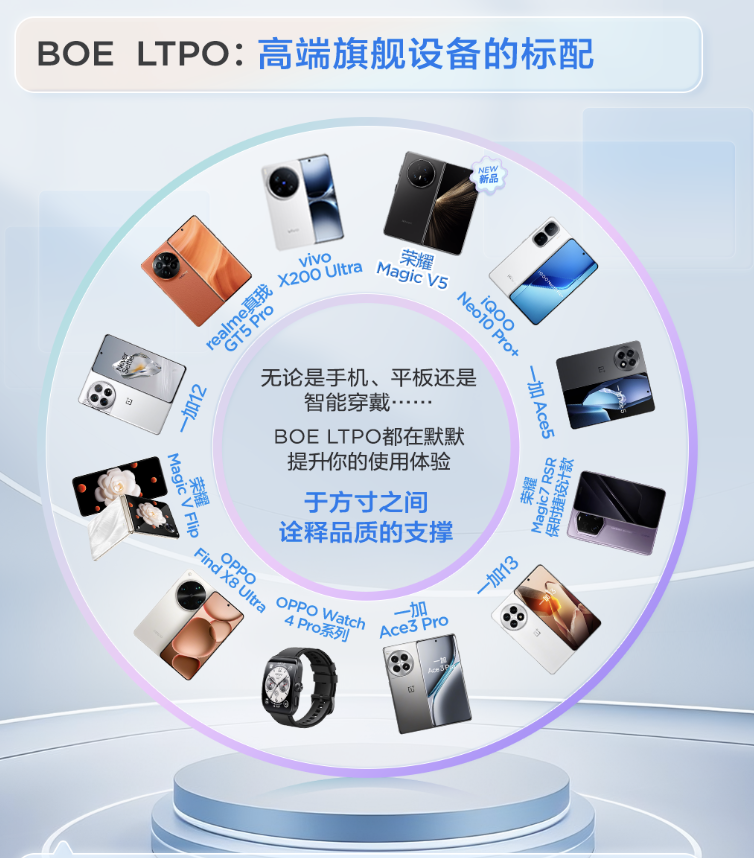Quick Guide of BOE LTPO Screen
In 2024, BOE (Beijing Oriental Electronics) quietly passed a milestone that few outside the display industry noticed: according to global analytics firm Sigmaintell, BOE is now the world’s No. 1 supplier of LTPO panels. Every month, tens of millions of flagship smartphones, smartwatches and tablets leave factories with a BOE screen inside—so, Why Mobile phone manufacturers Choosing BOE LTPO Screens?
This article is the answer.
1. What is LTPO:
LTPO means Low-Temperature Polycrystalline Oxide. This technology is used in many new smartphone and smartwatch screens. LTPO uses two kinds of thin-film transistors: LTPS and Oxide TFTs. Each one has its own special job. LTPS transistors help pixels change fast, so moving things look smooth. Oxide TFTs use less power, which is good when the screen is not moving.
What Makes BOE's LTPO Technology Different?
BOE LTPO display technology = LTPS (Low Temperature Polysilicon) + IGZO (Indium Gallium Zinc Oxide).
By stacking two semiconductor materials on the same backplane, It combines the high electron mobility of LTPS with the low leakage characteristics of IGZO.
2. Three Benefits
1. Intelligent refresh rate adjustment: smoothness and eye care combined
One of the most notable features of BOE LTPO screens is their intelligent refresh rate adjustment capability. While traditional screens can only operate at fixed refresh rates, LTPO technology can achieve dynamic adjustments in the range of 1Hz to 144Hz.
Static mode: The screen does not flicker, the refresh rate is reduced to 30Hz and flicker is reduced by 66%. This reduces dizziness and protects your eyes.
Dynamic mode: The refresh rate increases to 120Hz and the flicker is reduced by 20%.
2. Revolutionary energy efficiency
The battery life of smart devices is always a problem, but BOE LTPO screens are extremely energy efficient. This is mainly due to two key technologies:
'Always-on display':Firstly, the ultra-low leakage characteristics of IGZO materials mean that the screen can reduce its refresh rate to an impressive 1Hz in standby mode. Tests have shown that, compared to traditional high refresh rate screens, this mode can save over 50% of the power, while still maintaining clear and stable images.
'Only display the necessary areas':BOE divides the screen into multiple small areas. When a notification is received, the screen does not fully illuminate, but only activates the area necessary to display the notification. This precise energy control means that devices with BOE LTPO screens have a significantly better battery life than similar products.
3. Intelligent scene recognition, automatic refresh rate adjustment
The intelligence of BOE LTPO screens goes beyond hardware to encompass their exceptional scene recognition capabilities. The screen can automatically identify the type of content being displayed (games, videos, web pages, etc.) and adjust the refresh rate strategy in real time based on user behaviour.
Scene examples:
Gaming (60Hz-120Hz): High refresh rate for smooth gameplay, with instant reduction in refresh rate for power saving when exiting.
Video/streaming (10Hz-120Hz): Smooth playback, with reduced refresh rate when paused.
Reading/web browsing (1Hz-10Hz): steady and flicker-free for eye comfort and energy saving.
3. Devices with BOE LTPO screens
Smartphones
• OnePlus Ace 3 Pro: 1–144 Hz adaptive, 5,500 mAh battery, 2-day real-world endurance.
• Magic V5:The thinnest 6100 mAh foldable flagship phone on the market right now.
More:Realme GT5 Pro, OPPO Find X8 Ultra, OnePlus 13, IQOO Neo10 Pro+ ……
Smartwatches
• OPPO Watch 4 Pro: 1 Hz always-on, 100 % DCI-P3, 3-day eSIM mode.

Summary:
LTPO is no longer a premium add-on; it’s the new baseline for flagship devices. With BOE’s volume leadership, global brands can now offer better screens without inflating prices.
Your next phone, watch or tablet may already hide a BOE LTPO panel behind its glass.
Quick Guide